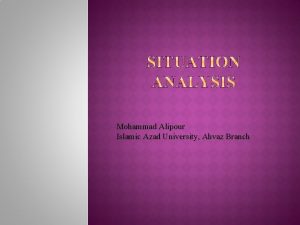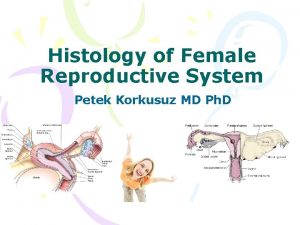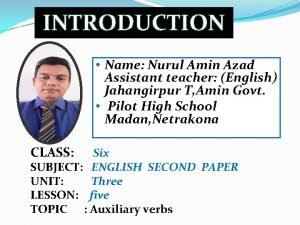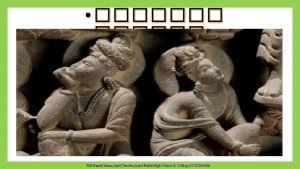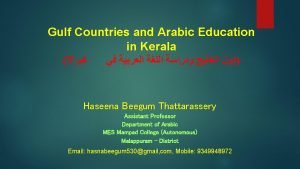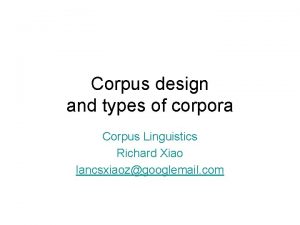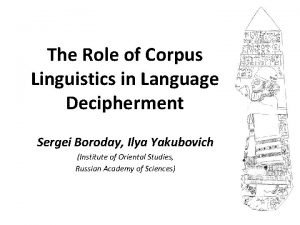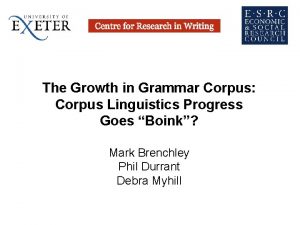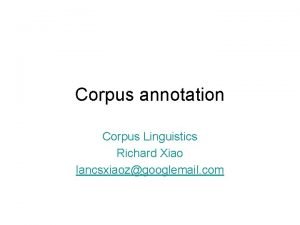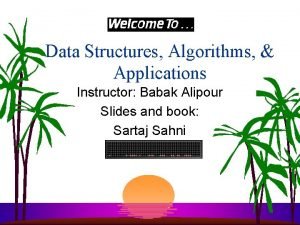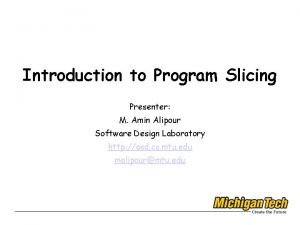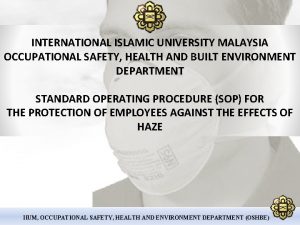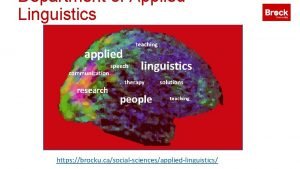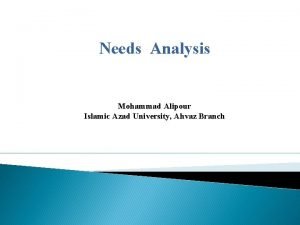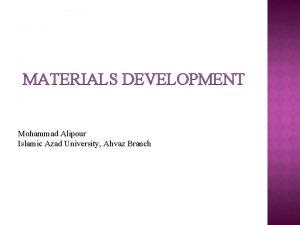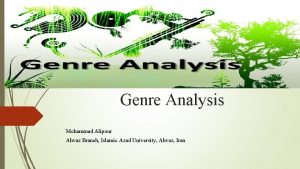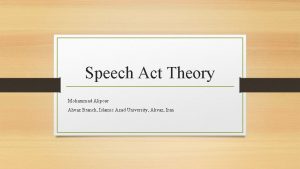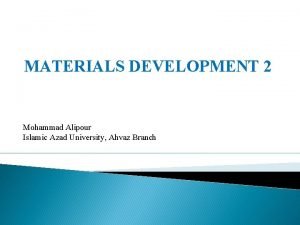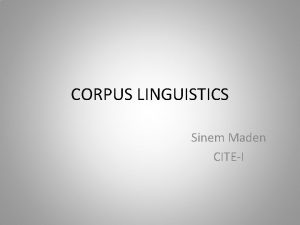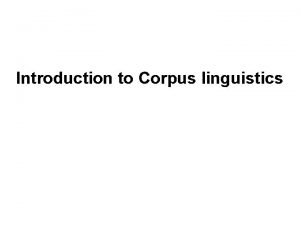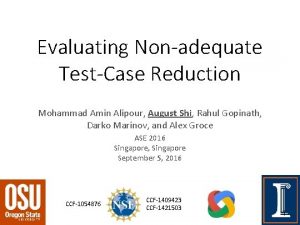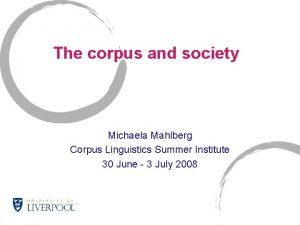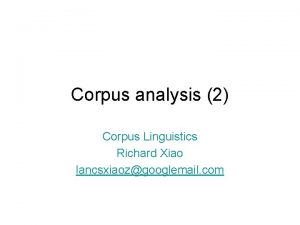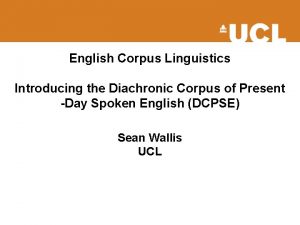Corpus Linguistics MOHAMMAD ALIPOUR ISLAMIC AZAD UNIVERSITY AHVAZ

















- Slides: 17

Corpus Linguistics MOHAMMAD ALIPOUR ISLAMIC AZAD UNIVERSITY, AHVAZ BRANCH

Corpus Linguistics History In the “pre-Chomskyan era”: “Corpora” where few paper slips with data. “Shoebox Corpora”: Non-representative. Corpus based in that methodology was empirical and based on observable data.

Corpus Linguistics History The revolutionary 60 s With the advances in computer technology the exploitation of massive corpora became feasible. From the 80 s onward, the number and size of corpora and corpus-based studies increased dramatically. Corpora have revolutionized almost all branches of linguistics. Computers: 1) allow us to speed up the processing of data, 2) avoid human bias in data analysis, 3) and allow the enrichment of data with metadata

Corpus Linguistics History Since the 1990 s, the corpus methodology has revolutionized nearly all branches of linguistics Corpus analysis can be illuminating in “virtually all branches of linguistics or language learning. ” (Leech 1997) Early studies used general corpora to carry out lexicographical research which led to the production of dictionaries. More recently, specialized corpora have been compiled in order to examine texts belonging to a particular register or genre, for example newspapers or academic discourse.

Corpus Linguistics What is Corpus Linguistics? Corpus linguistics can be described as the study of language based on text corpora. The study of language based on examples of “real life“ language use.

What is a corpus? “A corpus is a collection of pieces of language that are selected and ordered according to explicit linguistic criteria in order to be used as a sample of the language”. (Sinclair 1996) It is an electronic collection of text both spoken and written, stored on a computer which can be easily retrieved for different application and uses. “A corpus is a collection of (1) machine-readable (2) authentic texts (including transcripts of spoken data) which is (3) sampled to be (4) representative of a particular language or language variety. ”

Characteristics of a Good Corpus large systematically assembled natural texts often available to other researchers spoken and/or written language usually in electronic form can be tagged for use with text manipulation programs

Types of Corpora 1) General 2) Special 1) General: One which attempts to represent language as a whole, not any specific part of language. Different genres are included, lectures, movies, newspapers, etc. For example: BNC, Includes both written and spoken (mostly written) Cambridge and Nottingham Corpus in Discourse in English (CANCODE) Michigan Corpus of Academic Spoken English (MICASE)

Types of Corpora 2)Special: Its more useful for use when you have a specific purpose in your mind and you want to conduct a study. You cantnot find a corpus related to your topic, so you should collect your own corpus. Specialized corpora have specific purposes and are used for single studies. The collection might be time consuming and difficult, but not like general ones. The frequency of individual words or phrases can be examined, and compared across sub-corpora, for example, in different genres or institutional contexts. Concordancing Programs show all the instances of the same lexical item in concordance lines.

Nature of Corpus-Based Approach It is empirical, analysing the actual patterns of use from natural texts It utilizes a large and principled collection of natural texts as the basis for analysis It makes extensive use of computers for analysis, using both automatic and interactive techniques It integrates both quantitative and qualitative analytical techniques

Corpus Data Collection Spoken data must be transcribed from audio recordings. Written text must be rendered machine-readable by keyboarding or OCR (Optical Character Recognition) scanning. Language data so collected form a RAW CORPUS.

Corpus Collection Considerations 1. Size 2. Manageability 3. Representativeness 4. Generalizability 5. Content or composition 6. Data Saturation

Synchronic Corpora vs. Diachronic Corpora Synchronic Corpora : Useful to compare varieties of English. Texts date all to the same period. Diachronic Corpora : Texts date to different periods in time. Ideal to study language change and history.

Concordancers Word. Smith 4, 5, Mike Scott Ant. Conc 3. 2. 1 Tenka Text 0. 1. 3 Concapp V 4 Simple Concordance Program Mono. Conc

Ant. Conc is a freeware, multiplatform tool for carrying out corpus linguistics research and data-driven learning.

Ant. Conc contains seven tools that can be accessed either by clicking on their 'tabs' in the tool window, or using the function keys F 1 to F 7. Concordance Tool: This tool shows search results in a 'KWIC' (Key. Word In Context) format. This allows you to see how words and phrases are commonly used in a corpus of texts. Concordance Plot Tool This tool shows search results plotted as a 'barcode' format. This allows you to see the position where search results appear in target texts. File View Tool This tool shows the text of individual files. This allows you to investigate in more detail the results generated in other tools of Ant. Conc. Clusters/N-Grams The Clusters Tool shows clusters based on the search condition. In effect it summarizes the results generated in the Concordance Tool or Concordance Plot Tool. The N-Grams Tool, on the other hand, scans the entire corpus for 'N' (e. g. 1 word, 2 words, …) length clusters. This allows you to find common expressions in a corpus. Collocates: This tool shows the collocates of a search term. This allows you to investigate non-sequential patterns in language. Word List: This tool counts all the words in the corpus and presents them in an ordered list. This allows you to quickly find which words are the most frequent in a corpus. Keyword List: This tool shows the which words are unusually frequent (or infrequent) in the corpus in comparison with the words in a reference corpus. This allows you to identify characteristic words in the corpus, for example, as part of a genre or ESP study

 Mohammad alipour
Mohammad alipour Uterus layers histology
Uterus layers histology Corpus luteum vs corpus albicans histology
Corpus luteum vs corpus albicans histology Amin azad
Amin azad Nazrul islam azad
Nazrul islam azad Azad jammu and kashmir divisions
Azad jammu and kashmir divisions Dr azad moopen
Dr azad moopen Types of corpora
Types of corpora What is decipherment
What is decipherment Corpus linguistics
Corpus linguistics Maxims of annotation in corpus linguistics
Maxims of annotation in corpus linguistics Babak alipour
Babak alipour Amin alipour
Amin alipour Language
Language History of applied linguistics
History of applied linguistics Oshbe
Oshbe Islamic university college
Islamic university college Brock university applied linguistics
Brock university applied linguistics
